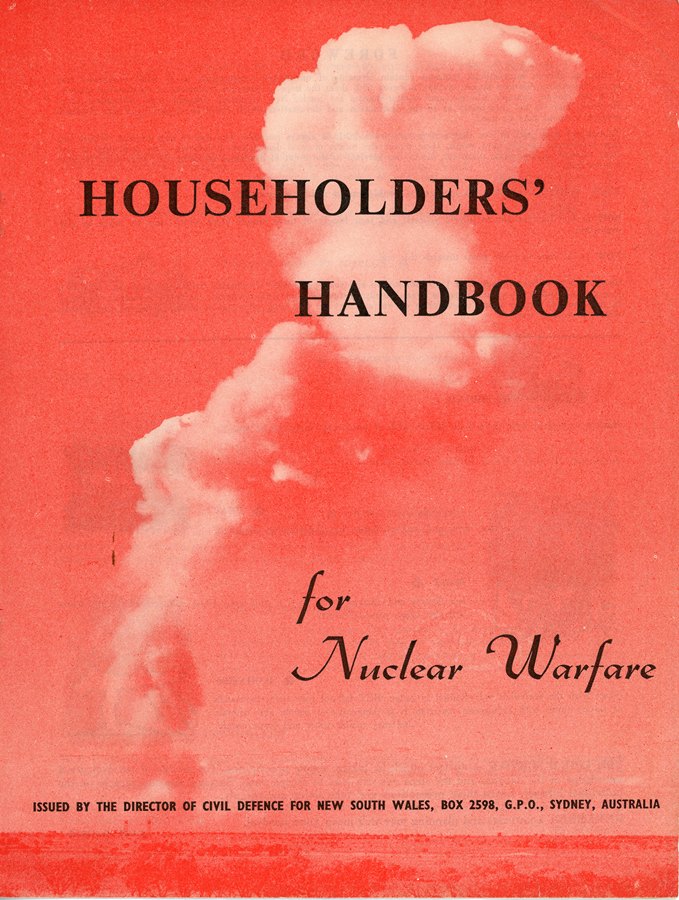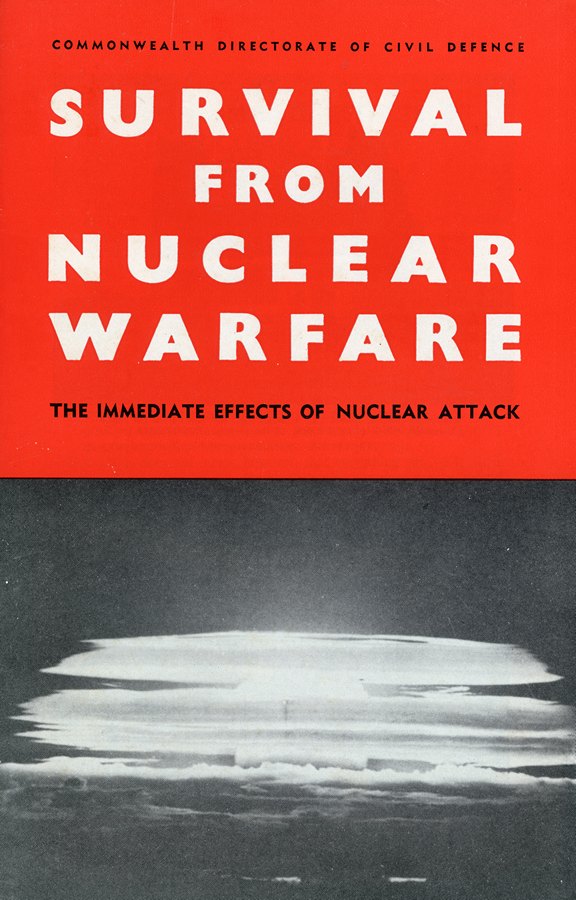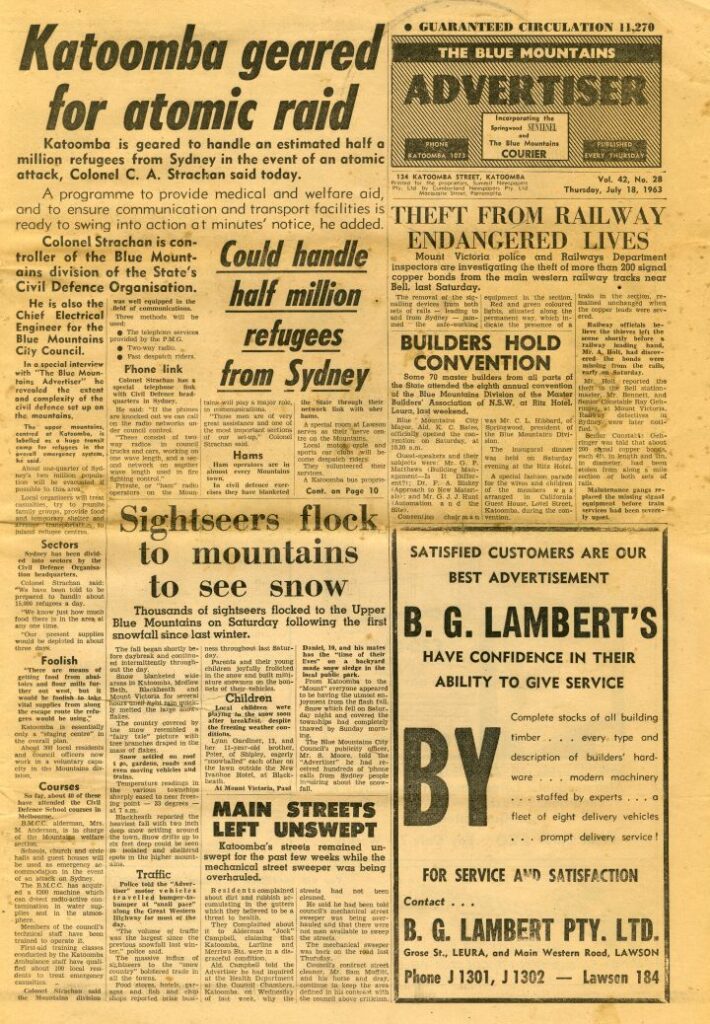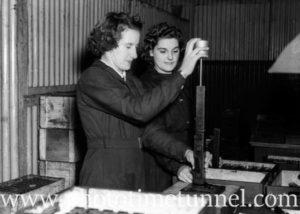Nuclear war loomed over my youth the way climate change looms over that of my children’s generation.
Hitting my teens in middle class white Australian society in the 1970s, I was acutely aware that the USA and the USSR were engaged in a tense Cold War and had built up vast arsenals of atomic and other weapons, arriving at the point where neither side could make a first strike against the other on account of what was called MAD – “mutually assured destruction”.
We had the destruction of the environment to worry about too, but were given to understand that the world’s governments were stepping up to address the issues of pollution and species extinction and we had examples before our eyes of genuine action that helped reassure us that the adults were responding to the crisis. Time was to show us that the forces of greed could and would derail effective responses, but at the time we might have been excused for believing the threat to the environment was being countered. Remember, we were very young and naïve.
But as for the nuclear threat, it hovered over our lives like a huge black bird of prey. We were told that nuclear-armed aircraft were circling the globe night and day, that nuclear submarines prowled the oceans loaded with warheads, that multiple missiles were pointed at every major city and strategic target within the boundaries of the opposing economic blocs.
We knew that both sides were jockeying for first-strike capability, like chess players striving for a one-piece advantage that would see them in front when the end-game arrived. Speaking personally, nuclear war haunted my dreams at times. I recall dreaming of being in a gathering of people outside when somebody pointed to the sky. We saw missiles streaking across the blue and knew we were witnessing the beginning of the end.
We didn’t have social media or the internet, of course. Our information and propaganda came to us through newspapers and magazines, television and radio and also direct from governments and other players in society. Religious nutters distributed leaflets urging us to join their ranks before it was too late. Peace activists urged us to join rallies and sign petitions calling for disarmament talks.
We were fed a solid diet of information about the potential effects a nuclear war might have on the world and on our personal lives and we were constantly warned of new and worse weapons either in production or on the drawing board.
Doomsday preppers
In Australia – firmly a part of the US Empire and the British Commonwealth – we had experienced a series of 12 nuclear tests on our soil and had slowly become aware of the unpleasant legacy of these tests. We also had the US and France testing nuclear weapons in our Pacific “back yard” and the negative effects of these tests gradually filtered into our national consciousness.
I own a small collection of brochures and pamphlets providing “helpful” advice on trying to survive a nuclear attack. They make for strange reading today, when such advice is often seen as ludicrous or futile. Long before the coining of the term “Doomsday prepper”, Australian households were being encouraged to lay in stocks of canned food and other supplies, have atomic warfare emergency plans and have a basic understanding of the likely effects of an atomic blast.
The Sunday Telegraph newspaper sponsored an Atomic Age Exhibition at the 1948 Sydney Royal Easter Show, with a 25 square metre (265 square foot) model of the atom-bombed Japanese city of Hiroshima. “By means of animated models and sound track, the dropping of the first atomic bomb to be used in war will be re-enacted every few minutes whilst the exhibition is open,” the magazine supplement promised. An ingot of uranium “many times more than existed in the world before 1940” was also on display.
Readers were warned that an atomic attack against Australia – most likely using missiles like the V2 rockets the Germans developed in World War 2 – might destroy all the nation’s cities and ten percent of the population within an hour.
The state of New South Wales – Australia’s most populous state of which Sydney is the capital city – issued a brochure in 1958 entitled Civil Defence is Your Business, which urged people to be prepared to whitewash their windows at short notice, to remove flammable curtains, dig a slit trench or shelter away from buildings. We were told to lay in water supplies and learn first aid. “We are no longer isolated. A nuclear war could affect you!” the brochure warned.


Another NSW publication was the Householders’ Handbook for Nuclear Warfare. This brochure noted that other forms of warfare such as chemical or biological attacks were possible, but offered advice for nuclear warfare only.
“Though we hope and believe that war is not probable, it is always possible. The risk is ever present. Whilst this risk exists and nations have within their power the means of mass destruction, it behoves every individual to give some thought to, and make plans for, his or her survival in the event of hostilities breaking out,” the brochure warned.
Householders were advised to heed official warnings and, if an alert was issued, to prepare their homes and fallout shelters for the crisis. Food stockpiles needed to be checked and topped up, doors and windows sealed, gas and electricity turned off, sanitary considerations provided for, pets rounded up, water stocked up in preparation for mains disruption, rainwater tanks blocked off and a battery powered radio made ready for use.
The Australian Commonwealth Directorate of Civil Defence issued a series of pamphlets in 1964: Survival from Nuclear Warfare – the immediate effects of nuclear attack; Protective Measures against Radiation from Fallout; Radioactive Fallout on Plants and Animals.
Readers were advised: “If you are in the open when there is a blinding flash (at which you must not look), lie down behind the nearest wall or shelter with your face away from the explosion, covered in your arms. If you cannot reach any shelter, throw yourself flat with the chest slightly raised from the ground, supporting the body on the elbows with hands clasped over the back of the head. Choose a gutter or any depression. Get the maximum cover from your clothes. If you are inside, dive under a table or bed out of the direct line of any windows. If you are in a car turn off the engine and get as low as you can with your face downward”.
“Gamma radiation has a cumulative effect and it is important, therefore, immediately after the first shocks of the explosion, to find shelter from fall out, which will commence to descend, depending on weather conditions, about half-an-hour after the explosion at a distance of five miles and later, of course, the further away you are.”
Radioactive fallout
Fallout shelters were a good idea, and a stock of food in airtight containers would be needed. These would have to be thoroughly washed, of course, and a supply of water should be laid in since the mains water would probably be disrupted.
“At present we do not think that Australia is likely to be attacked with nuclear weapons. Should the strategical circumstances change we have the advantage of our great continent, and targets which might come under attack could be hundreds of miles apart, therefore we have less need to fear a widespread distribution of fallout. The difficulty is, however, that we cannot tell from which direction the winds would blow after an explosion, and, therefore, no one within two to three hundred miles of a nuclear explosion on the ground could be sure that they would not be exposed to radioactive fallout.”
Some private enterprises also offered their own printed advice on the problems of nuclear war. Newcastle (NSW) pest controller Thomas Cowan and Co published a flyer posing the question: What are the Potential Pest Control Problems in an Atomic-Bombed Community? The company warned that: “A direct result of the crowding and unsanitary conditions under which refugee and homeless populations will live after an atomic explosion may well be outbreaks of various insect and fungal infections of the skin and hair.” It observed that London people, driven underground by German bombs in World War 2, suffered terribly from lice, ringworm and scabies, and concluded – perhaps illogically – that now was a good time to hire a pest control company to deal with white ants, cockroaches and borers.

Across Australia, civil defence organisations prepared detailed plans for the evacuation of large numbers of refugees from the anticipated target areas. In NSW, Newcastle, Sydney and Wollongong were expected to be the major targets.
Perhaps all this nightmare publicity about nuclear war was helpful. It might, at least, have contributed to public pressure for strategic arms limitation, some agreements for which did come into effect – at least for a time.
Fast-forward to 2022 and it seems the nuclear-armed powers feel no need for arms control treaties and are instead reconsidering ways in which nuclear weapons might be used in a decisive first strike or, alternatively, as tactical battlefield options.
Certainly, it seems to me, the world has become blasé about the nuclear threat.
But then, it’s a different world from the one in which I grew up in the 1960s and 1970s.
If our leaders have given up on arms control they seem also to have largely given up on pollution control along with democracy and either economic or social justice. They’ve refined their systems of propaganda and are now seemingly entirely beholden to the interests of big corporations which have no loyalty to humanity or our planet.
Growing up under the nuclear shadow was tense and troubling, for me at least.
But looking at the world now through the eyes of the young and seeing the triumph of greed at the highest levels in every sphere of life I must admit the spectre of the bomb – though terrible – is now standing in company with several others equally grim.
And, unfortunately, we aren’t being handed helpful official brochures about surviving the corporate takeover of our lives, about avoiding economic serfdom in the service of a rogue malignant minority, about reclaiming the world for peace or about preserving the Earth for the children of our children.
We are going to have to write them ourselves.



